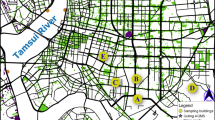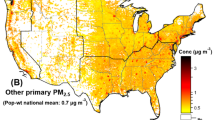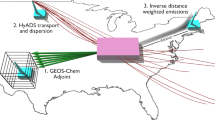Abstract
During the past three decades, receptor models have been used to identify and apportion ambient concentrations to sources. A number of groups are employing these methods to provide input into air quality management planning. A workshop has explored the use of resolved source contributions in health effects models. Multiple groups have analyzed particulate composition data sets from Washington, DC and Phoenix, AZ. Similar source profiles were extracted from these data sets by the investigators using different factor analysis methods. There was good agreement among the major resolved source types. Crustal (soil), sulfate, oil, and salt were the sources that were most unambiguously identified (generally highest correlation across the sites). Traffic and vegetative burning showed considerable variability among the results with variability in the ability of the methods to partition the motor vehicle contributions between gasoline and diesel vehicles. However, if the total motor vehicle contributions are estimated, good correspondence was obtained among the results. The source impacts were especially similar across various analyses for the larger mass contributors (e.g., in Washington, secondary sulfate SE=7% and 11% for traffic; in Phoenix, secondary sulfate SE=17% and 7% for traffic). Especially important for time-series health effects assessment, the source-specific impacts were found to be highly correlated across analysis methods/researchers for the major components (e.g., mean analysis to analysis correlation, r>0.9 for traffic and secondary sulfates in Phoenix and for traffic and secondary nitrates in Washington. The sulfate mean r value is >0.75 in Washington.). Overall, although these intercomparisons suggest areas where further research is needed (e.g., better division of traffic emissions between diesel and gasoline vehicles), they provide support the contention that PM2.5 mass source apportionment results are consistent across users and methods, and that today's source apportionment methods are robust enough for application to PM2.5 health effects assessments.
This is a preview of subscription content, access via your institution
Access options
Subscribe to this journal
Receive 6 print issues and online access
$259.00 per year
only $43.17 per issue
Buy this article
- Purchase on Springer Link
- Instant access to full article PDF
Prices may be subject to local taxes which are calculated during checkout




Similar content being viewed by others
References
Anderson M.J., et al. Source apportionment of exposure to toxic volatile organic compounds using Positive Matrix Factorization. J Exp Anal Environ Epidemiol 2001: 1: 295–307.
Anderson M.J., et al. Source apportionment of exposures to volatile organic compounds: II. Application of receptor models to TEAM study data. Atmos Environ 2002: 36: 3643–3658.
Anttila P., et al. Application of Positive Matrix Factorization to source apportionment: results of a study of bulk deposition chemistry in Finland. Atmos Environ 1995: 29: 1705–1718.
Begum B.A., et al. Investigation of sources of atmospheric aerosol at urban and semi-urban areas in Bangladesh. Atmos Environ 2004: 38: 3025–3038.
Blifford Jr. I.H., and Meaker G.O. A factor analysis model of large scale pollution. Atmos Environ 1967: 1: 147–157.
Buzcu B., et al. Source identification and apportionment of fine particulate matter in Houston, TX, using Positive Matrix Factorization. Environ Eng Sci 2003: 20: 533–545.
Chow J.C., et al. The DRI thermal/optical reflectance carbon analysis system: description, evaluation and applications in US air quality studies. Atmos Environ 1993: 27A(8): 1185–1201.
Chow J., and Watson J. Review of PM2.5 and PM10 apportionment for fossil fuel combustion and other sources by the chemical mass balance receptor model. Energy Fuels 2002: 16: 222–260.
Christensen W.F., et al. Iterated confirmatory factor analysis for pollution source apportionment. Brigham Young University, Department of Statistics Technical Report Series #SD-101-R. Environmetrics 2004. Submitted.
Christensen W.F., and Sain S.R. Accounting for dependence in a flexible multivariate receptor model. Technometrics 2002: 44: 328–337.
Chueinta W., et al. Investigation of sources of atmospheric aerosol urban and suburban residential areas in Thailand by Positive Matrix Factorization. Atmos Environ 2000: 34: 3319–3329.
Chueinta W., et al. A multilinear model for spatial pattern analysis of the measurement of haze and visual effects (MOHAVE) project. Environ Sci Technol 2004: 38: 544–554.
Claiborn C.S., et al. Testing the metals hypothesis in Spokane, Washington. Environ Health Persp 2002: 110: 547–552.
Cooper J.A., et al. The effective variance weighting for least squares calculations applied to the mass balance receptor model. Atmos Environ 1984: 18: 1347–1355.
Gao N., et al. Receptor modeling for airborne ionic species collected in SCAQS, 1987. Atmos Environ 1994: 28: 1447–1470.
Gao S., et al. Aerosol chemistry, and light-scattering and hygroscopicity budgets during outflow from East Asia. J Atmos Chem 2003: 46: 55–88.
Gleser L.J. Some thoughts on chemical mass balance models. Chemometrics Intell Lab Systems 1997: 37: 15–22.
Harman H.H. Modern Factor Analysis, 3rd edn. Rev. University of Chicago Press: Chicago, 1976.
Henry R.C. Current factor analysis models are ill-posed. Atmos Environ 1987: 21: 1815–1820.
Henry R.C. History and fundamentals of multivariate air quality receptor models. Chemom Intell Lab Systems 1997: 37: 37–42.
Henry R.C. Multivariate receptor modeling by N-dimensional edge detection. Chemom Intell Lab Systems 2003: 65: 179–189.
Henry R.C. Duality in multivariate receptor models. Chemom Intell Lab Systems 2005: 77: 59–63.
Henry R. . et al. Comparing a new algorithm with the classic methods for estimating the number of factors. Chemom Intell Lab Systems 1999: 48: 91–97.
Henry R.C., and Kim B.M. Extension of self-modeling curve resolution to mixtures of more than three components. Part 1: finding the basic feasible region. Chemom Intell Lab Systems 1990: 8: 205–216.
Hien P.D., et al. PMF receptor modelling of fine and coarse PM10 in air masses governing monsoon conditions in Hanoi, Northern Vietnam. Atmos Environ 2004: 38: 189–201.
Hopke P.K., et al. The use of multivariate analysis to identify sources of selected elements in the Boston Urban Aerosol. Atmos Environ 1976: 10: 1015–1025.
Hopke P.K., et al. Receptor modeling of ambient and personal exposure samples: 1998 Baltimore particulate matter epidemiology-exposure study. Atmos Environ 2003: 37: 3289–3302.
Huang S., et al. Testing and optimizing two factor-analysis techniques on aerosol at Narragansett, Rhode Island. Atmos Environ 1999: 33: 2169–2185.
Ito K., Christensen W., Eatough D.J., Henry R.C., Kim E., Laden F., Lall R., Larson T.V., Neas L., Hopke P.K., and Thurston G. An investigation of inter-method variability in associations between source-apportioned fine particle mass and daily mortality in Washington, DC. J Expos Anal Environ Epidemiol 2005, submitted.
Kim B.M., and Henry R.C. Extension of self-modeling curve resolution to mixtures of more than three components. Part 2: finding the complete solution. Chemom Intell Lab Syst 1999: 49: 67–77.
Kim B.M., and Henry R.C. Extension of self-modeling curve resolution to mixtures of more than three components — Part 3. Atmospheric aerosol data simulation studies. Chemom Intell Lab Systems 2000: 52: 145–154.
Kim E., and Hopke P.K. Source apportionment of fine particles at Washington, DC utilizing temperature resolved carbon fractions. J Air Waste Manage Assoc 2004a: 54: 773–785.
Kim E., and Hopke P.K. Improving source identification of fine particles in a rural Northeastern US area utilizing temperature resolved carbon fractions. J Geophys Res 2004b: 109: D09204.
Kim E., et al. Source identification of atlanta aerosol by Positive Matrix Factorization. J Air Waste Mange Assoc 2003a: 53: 731–739.
Kim E., et al. Source identification of PM2.5 in an arid northwest U.S. city by Positive Matrix Factorization. Atmospheric Res 2003b: 66: 291–305.
Kim E., et al. Incorporation of parametric factors into multilinear receptor model studies of Atlanta Aerosol. Atmospheric Environ 2003c: 37: 5009–5021.
Kim E., et al. Improving source identification of Atlanta aerosol using temperature resolved carbon fractions in Positive Matrix Factorization. Atmospheric Environ 2004: 38: 3349–3362.
Koutrakis P., and Spengler J.D. Source apportionment of ambient particles in Steubenville, OH using specific rotation factor analysis. Atmos Environ 1987: 21: 1511–1519.
Laden F., et al. Association of fine particulate matter from different sources with daily mortality in six US cities. Environ Health Perspect 2000: 108: 941–947.
Larsen R.K., and Baker J.E. Source apportionment of polycyclic aromatic hydrocarbons in the urban atmosphere: a comparison of three methods. Environ Sci Technol 2003: 37: 1873–1881.
Larson T., et al. Source apportionment of indoor, outdoor and personal PM2.5 in Seattle, WA using Positive Matrix Factorization. J Air Waste Manage Assoc 2004: 54: 1175–1187.
Lawson C.L., and Hanson R.J. Solving Least-Squares Problems. Prentice-Hall: Englewood Cliffs, NJ, 1974.
Lee E., et al. Application of Positive Matrix Factorization in source apportionment of particulate pollutants in Hong Kong. Atmos Environ 1999: 33: 3201–3212.
Lee J.H., et al. Identification of sources contributing to the Mid-Atlantic regional aerosol. J Air Waste Manage 2002: 52: 1186–1205.
Lee P.K.H., et al. Identification of the major sources contributing to PM2.5 observed in Toronto. Environ Sci Technol 2003: 37: 4831–4840.
Lewis C.W., et al. Source apportionment of phoenix PM2.5 aerosol with the UNMIX receptor model. J Air Waste Manage Assoc 2003: 53: 325–338.
Malinowski E.R. Factor Analysis in Chemistry, 2nd edn. Wiley: New York, 1991.
Mar T.F., et al. Associations between air pollution and mortality in Phoenix, 1995–1997. Environ Health Perspect 2000: 108: 347–353.
Mar T.F., Koenig J.Q., Larson T.V., Christensen W., Eatough D.J., Henry R.C., Ito K., Kim E., Laden F., Lall R., Neas L., Hopke P.K., and Thurston G. An investigation of inter-method variability in associations between source-apportioned fine particle mass and daily mortality in Phoenix, AZ. J Expo Anal Environ Epidemiol 2005. submitted.
Maykut N.N., et al. Source apportionment of PM2.5 at an urban IMPROVE site in Seattle, Washington. Environ Sci Technol 2003: 37: 5135–5142.
Miller M.S., et al. A chemical element balance for the Pasadena aerosol. J Colloid Interface Sci 1972: 39: 165–176.
Miller S.L., et al. Source apportionment of exposures to volatile organic compounds. I. Evaluation of receptor models using simulated exposure data. Atmos Environ 2002: 36: 3629–3641.
Ozkaynak H., and Thurston G.D. Associations between 1980 US mortality rates and alternative measures of airborne particle concentration. Risk Anal 1987: 7: 449–460.
Paatero P. Least squares formulation of Robust, non-negative factor analysis. Chemom Intell Lab Systems 1997: 37: 23–35.
Paatero P. The multilinear engine — a table-driven least squares program for solving multilinear problems, including the n-way parallel factor analysis model. J Comput Graph Stat 1999: 8: 854–888.
Paatero P., and Hopke P.K. Utilizing wind direction and wind speed as independent variables in multilinear receptor modeling studies. Chemom Intell Lab Systems 2002: 60: 25–41.
Paatero P., and Tapper U. Analysis of different modes of factor analysis as least squares fit problems. Chemometr Intell Lab Systems 1993: 18: 183–194.
Paatero P., and Tapper U. Positive Matrix Factorization: a non-negative factor model with optimal utilization of error estimates of data values. Environmetrics 1994: 5: 111–126.
Paatero P., et al. Understanding and controlling rotations in factor analytic models. Chemom Intell Lab Systems 2002: 60: 253–264.
Paatero P., et al. Advanced factor analysis of spatial distributions of PM2.5 in the Eastern U.S. Environ Sci Technol 2003: 37: 2460–2476.
Paatero P., et al. A graphical diagnostic method for assessing the rotation in factor analytical models of atmospheric pollution. Atmos Environ 2005: 39: 193–201.
Park E.S., et al. Estimating the number of factors to include in a high-dimensional multivariate bilinear model. Commun Stat Simul Comput 2000: 29: 723–746.
Paterson K.G., et al. Analysis of air quality data using Positive Matrix Factorization. Environ Sci Technol 1999: 33: 635–641.
Polissar A.V., et al. The ratio of aerosol optical absorption coefficients to sulfur concentrations, as an indicator of smoke from forest fires when sampling in polar regions. Atmos Environ 1996: 30: 1147–1157.
Polissar A.V., et al. Atmospheric aerosol over Alaska: 2. Elemental composition and sources. J Geophys Res 1998: 103: 19045–19057.
Polissar A.V., et al. The aerosol at Barrow, Alaska: long-term trends and source locations. Atmos Environ 1999: 33: 2441–2458.
Polissar A.V., et al. Atmospheric aerosol over Vermont: chemical composition and sources. Environ Sci Technol 2001: 35: 4604–4621.
Prendes P., et al. Source apportionment of inorganic ions in airborne urban particles from Coruna city (NW of Spain) using Positive Matrix Factorization. Tatlanta 1999: 49: 165–178.
Qin Y., and Oduyemi K. Atmospheric aerosol source identification and estimates of source contributions to air pollution in Dundee, UK. Atmos Environ 2003: 37: 1799–1809.
Qin Y., et al. Comparative testing of PMF and CFA models. Chemometr Intell Lab Systems 2002: 61: 75–87.
Ramadan Z., et al. Identification of sources of Phoenix aerosol by Positive Matrix Factorization. J Air Waste Manage Assoc 2000: 50: 1308–1320.
Ramadan Z., et al. Comparison of Positive Matrix Factorization (PMF) and multilinear engine (ME-2) for the source apportionment of particulate pollutants. Chemom Intell Lab Systems 2003: 66: 15–28.
Roscoe B.A., et al. The use of principal components factor analysis to interpret particulate compositional data sets. J Air Pollut Control Assoc 1982: 32: 637–642.
Shah S.D., et al. Emission rates of particulate matter and elemental and organic carbon from in-use diesel engines. Environ Sci Technol 2004: 38: 2544–2550.
Song X.H., et al. Source of fine particle composition in the Northeastern US Atmospheric Environ 2001: 35: 5277–5286.
Thurston G.D., and Spengler J.D. A quantitative assessment of source contributions to inhalable particulate matter pollution in Metropolitan Boston. Atmos Environ 1985: 19: 9–26.
Thurston G.D., et al. The workshop on the source apportionment of PM health effects: inter-comparison of results and implications. Environ Health Persp 2005: in press.
Watson J.G., et al. The USEPA/DRI chemical mass balance receptor model, CMB 7.0. Environ Software 1990: 5: 38–49.
Winchester J.W., and Nifong G.D. Water pollution in Lake Michigan by trace elements from pollution aerosol fallout. Water Air Soil Pollut 1971: 1: 50–64.
Xie Y.L., et al. Identification of source nature and seasonal variations of Arctic aerosol by Positive Matrix Factorization. J Atmos Sci 1999a: 56: 249–260.
Xie Y.L., et al. Identification of source nature and seasonal variations of Arctic aerosol by the multilinear engine. Atmos Environ 1999b: 33: 2549–2562.
Yang H. Confirmatory factor analysis and its application to receptor modeling. Unpublished Ph.D. dissertation, University of Pittsburgh, Department of Mathematics and Statistics, 1994.
Zhou L., et al. Advanced factor analysis on Pittsburgh particle size distribution data. Aerosol Sci Technol 2004: 38(S1): 118–132.
Acknowledgements
The Workshop was organized under the auspices of the participating US EPA PM Health Effects Research Centers (Grant R827351 at NYU, R827351 at the University of Washington, R827353 at Harvard University, and R927354 at the University of Rochester). We thank the individual researchers who undertook participation in this workshop, often on their own time and resources. The information in this document has been subjected to review by EPA's National Health and Environmental Effects Research Laboratory and approved for publication. Approval does not signify that the contents reflect the views of the Agency, nor does mention of trade names or commercial products constitute endorsement or recommendation for use. Support for the organization and administration of the workshop was also provided by the New York State Energy Research and Development Authority (NYSERDA Grant 375-34215). We also thank Columbia University's Arden House Conference Center in Harriman, NY for hosting the May, 2003 workshop that led to the writing of this manuscript.
Author information
Authors and Affiliations
Corresponding author
Rights and permissions
About this article
Cite this article
Hopke, P., Ito, K., Mar, T. et al. PM source apportionment and health effects: 1. Intercomparison of source apportionment results. J Expo Sci Environ Epidemiol 16, 275–286 (2006). https://doi.org/10.1038/sj.jea.7500458
Received:
Accepted:
Published:
Issue Date:
DOI: https://doi.org/10.1038/sj.jea.7500458
Keywords
This article is cited by
-
Wintertime investigation of PM10 concentrations, sources, and relationship with different meteorological parameters
Scientific Reports (2024)
-
Chemical characteristics, morphology and source apportionment of PM10 over National Capital Region (NCR) of India
Environmental Monitoring and Assessment (2024)
-
Chemical and morphological characterization of PM2.5 samples collected over an urban industrial region Raipur, Chhattisgarh
Acta Geophysica (2023)
-
Compositional mapping, uncertainty assessment, and source apportionment via pollution assessment-based receptor models in urban and peri-urban agricultural soils
Journal of Soils and Sediments (2023)
-
Utilize the UV-Visible Region for Reduction of NO by Methylene Blue-Doped TiO2 for Photocatalysis
Transactions on Electrical and Electronic Materials (2022)



